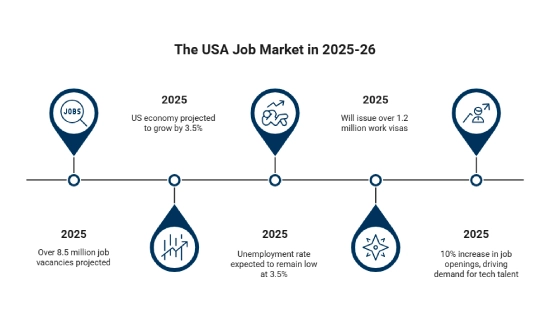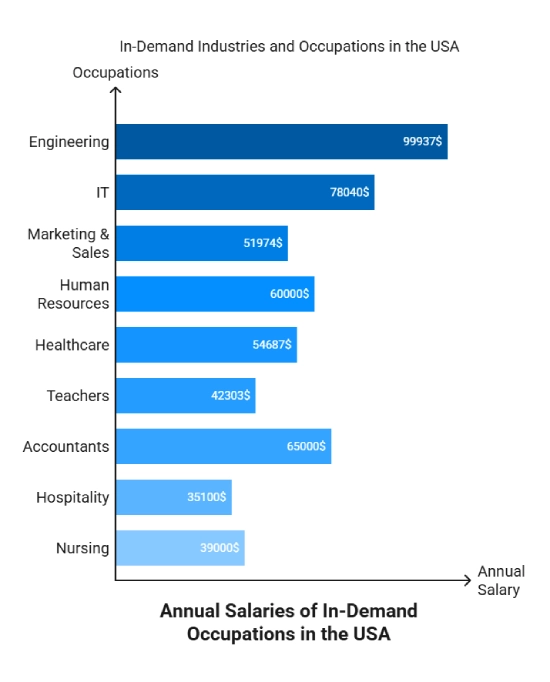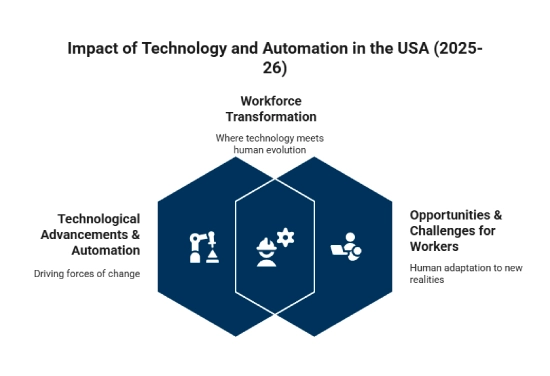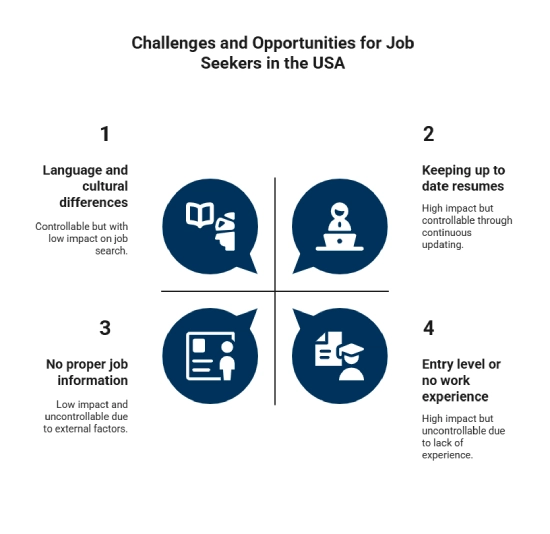The USA Job Market in 2025-30
The USA job market in 2025-30 is expected to be dynamic, shaped by emerging technologies, demographic changes, and evolving industries. In-demand occupations and key skill sets will evolve, creating opportunities for professionals to navigate the ever-changing workforce landscape. From the impact of automation to the rise of remote work, the labor market will continue to transform, offering new challenges and opportunities for job seekers and employers alike.
Key Points:
- USA job market will have over 8.5 million job vacancies
- US economy is projected to grow by 3.5%
- Unemployment rate is expected to remain low at 3.5%
- Will issue over 1.2 million work visas
- 10% increase in job openings, driving the demand for tech talent

*Planning for US Immigration? Y-Axis will guide you in step by step process.
Job Outlook in the USA 2025-30
The job outlook in the USA for 2025-30is promising, with significant growth anticipated in various sectors. The Bureau of Labor Statistics (BLS) projects strong job growth, especially in healthcare, technology, and business services. In-demand skills in these fields will drive job creation, while automation and digital transformation may reshape certain industries. Flexibility in work arrangements, such as remote and hybrid models, will further define the future of work.
Understanding the USA Job Outlook for Job Seekers and Employers
In 2025-30, the USA job market will continue its positive trajectory, with an expanding economy and growing sectors like healthcare, technology, and engineering. For job seekers, the outlook is favorable, particularly for those with high-demand skills in areas like AI, data science, and cybersecurity. The rise of remote work and hybrid employment options will also contribute to broader job opportunities. Employers will continue to seek a mix of technical skills and soft skills such as adaptability, creativity, and communication, which are highly valued in the evolving labor market.
General Employment Trends in the USA
The USA’s employment trends in 2025-30 show a shift towards digitalization and automation. As businesses embrace new technologies, more job opportunities are expected in tech-driven industries, but there will also be a reduction in some roles that can be automated. Additionally, sectors such as healthcare and renewable energy will experience consistent growth due to population aging and sustainability goals. The gig economy will also see an increase, with more flexible work arrangements becoming commonplace across industries.
Factors Influencing Job Creation or Reduction
Several factors will influence job creation or reduction in 2025-30. Technological advancements, particularly in automation and AI, will lead to the creation of new roles, especially in software development, data analytics, and robotics. However, automation may reduce positions in manufacturing and administrative roles. Demographic shifts, such as an aging population, will drive demand for healthcare services, leading to job growth in that sector. Government policies focused on infrastructure, clean energy, and job training will also contribute to employment growth, while economic recessions or global trade changes may impact some sectors negatively.
In-Demand Industries and Occupations in the USA
Certain industries will experience substantial growth in the USA in 2025-30, offering a wide array of job opportunities. Key sectors driving job creation include:
|
Occupations |
Salary (annually) |
|
Engineering |
$99,937 |
|
IT |
$78,040 |
|
Marketing & Sales |
$51,974 |
|
Human Resources |
$60,000 |
|
Healthcare |
$54,687 |
|
Teachers |
$42,303 |
|
Accountants |
$65,000 |
|
Hospitality |
$35,100 |
|
Nursing |
$39,000 |

Workforce Demands in the USA (2025-30)
The workforce demands in the USA are set to evolve significantly in 2025-30. Technology-related fields will continue to dominate, with a sharp increase in demand for software developers, AI specialists, data scientists, and cybersecurity professionals. Additionally, sectors such as healthcare will see sustained demand due to an aging population and the need for care services. Skilled trades, engineering roles, and renewable energy jobs are expected to grow as the government invests in infrastructure and clean energy initiatives. The demand for soft skills, including leadership, communication, and adaptability, will also be crucial in industries seeking well-rounded professionals.
Examination of Job Market in the USA (2025-30)
The job market in the USA will remain competitive in 2025-30, characterized by the ongoing recovery and growth following the pandemic. With a low unemployment rate, the labor market will be tight, especially in tech, healthcare, and professional services sectors. While there will be new job creation in high-demand industries, automation and AI are expected to disrupt traditional roles in manufacturing, retail, and administrative functions. Remote and hybrid work arrangements will continue to be popular, offering job seekers more flexibility. Although some sectors like hospitality and travel will continue to recover, the tech-driven sectors are projected to lead the job market.
Highlighting Areas with Notable Job Opportunities
Certain regions and industries in the USA will experience notable job growth in 2025-30. Cities like San Francisco, Austin, New York, and Seattle will continue to see high demand for tech professionals, particularly in AI, software development, and data science. Healthcare jobs, especially for nurses, doctors, and therapists, will see the most demand across the country, particularly in areas with large aging populations such as Florida and Arizona. Additionally, the green energy sector will see job growth in areas like solar and wind energy as the country invests more in sustainable solutions. Engineering and skilled trades will continue to have strong opportunities in manufacturing hubs like Detroit, while remote work opportunities will provide flexibility for professionals across industries, especially in marketing, project management, and customer service.
*Willing to work in the US? Y-Axis will guide you in all the steps.
Impact of Technology and Automation in the USA (2025-30)
The United States job market has witnessed robust advancements in technology and automation; this drives a demand for skilled workers to fill job opportunities across various sectors:
- Technological Advancements and Automation Shaping the Job Market
Technological advancements and automation are playing a transformative role in shaping the job market in the USA. By 2025, industries like manufacturing, logistics, and customer service are likely to see further integration of robotics, AI, and machine learning, leading to increased efficiency but also reducing the need for certain manual and repetitive jobs. Automation will streamline processes, enhance productivity, and create more sophisticated roles requiring technical expertise in programming, machine maintenance, and AI-driven innovation. The tech sector itself will experience a boom, with high demand for AI specialists, software developers, data scientists, and cybersecurity professionals.
- Potential Opportunities and Challenges for Workers in the Evolving Landscape
The rise of automation and AI will present both opportunities and challenges for workers. On one hand, the technology boom will lead to job creation in high-skill roles, especially in tech-related fields such as AI, data analytics, and cloud computing. This creates new career pathways for workers who upskill in these areas. On the other hand, there will be challenges, particularly for workers in sectors vulnerable to automation, such as manufacturing, retail, and administrative positions. Workers displaced by automation will need to embrace reskilling and upskilling programs to remain competitive in the job market. While some jobs will be lost, new jobs will emerge in industries focused on managing, maintaining, and advancing these technological systems. Therefore, adaptability and a willingness to learn will be key to thriving in this evolving landscape.

Skills in Demand in the USA
As the job market in the USA evolves, certain skills will be highly sought after by employers in 2025. These skills span across multiple sectors, including tech, healthcare, and business services:
Key skills sought by employers in the USA
- Problem-Solving
- Adaptability
- Flexibility
- Communication
- Collaboration
- Creativity
- Leadership
- Teamwork
- Time Management
- Digital Literacy
- Critical Thinking
- Emotional Intelligence
- Resilience
- Customer Service
- Foreign Language Proficiency
- Cultural Competence
Importance of up skilling or reskilling for job seekers
Upskilling and reskilling are crucial for professional development that promotes flexibility, job relevance, and future career resilience. Through reskilling, employees may update their skill sets and ensure that they continue to be proficient and effective in their employment. Employers who stay ahead by reskilling and upskilling are better positioned to get opportunities in the competitive job market and also ensure continued contribution to their organizations. This approach not only provides individuals with benefits but also provides with a culture of continuous learning within organizations, promoting innovation and adaptability.
Remote Work and Flexible Arrangements
The rise of remote work in the USA will continue in 2025, with many companies offering flexible work arrangements. This trend will impact industries like IT, marketing, and customer service, where remote work has proven effective. Job seekers should be prepared to work in flexible environments and highlight remote work capabilities in their applications.
- Exploration of the continuing trend of remote work
Companies in the US are opting for hybrid work more that enables workers to split between office and remote work. Through this, employees are able to work flexibly and have work life balance. This not only offers work life balance, but also has benefits such as reduced stress, and access to a broader talent pool for employers.
Implication for both Employers and Employees:
- For Employers: Remote work allows for a broader talent pool, reducing geographical limitations.
- For Employees: Flexibility in work hours and location will remain attractive, increasing work-life balance and overall productivity.
Employees working remotely have more control over their daily schedules and have a better work life balance and tend to be more productive and innovative. Furthermore, working remotely broadens career prospects by allowing employees to access job opportunities outside of their local area, and enhances overall job satisfaction and well-being.
Government Policies and Initiatives
The US government will continue to support workforce development through policies and funding, particularly in emerging sectors like tech, healthcare, and green energy. Programs aimed at reskilling workers and creating job opportunities in high-demand fields will play a key role in shaping the job market. Initiatives like the "Build Back Better" plan will drive infrastructure development, creating job opportunities in construction, engineering, and renewable energy sectors.
Overview of Government Programs or Policies Influencing Employment
In response to the shifting job market, the US government has implemented several policies aimed at creating job opportunities and addressing workforce challenges. Programs such as the Workforce Innovation and Opportunity Act (WIOA) are designed to offer training and job placement services to help workers transition to new roles. Additionally, the Biden administration has introduced initiatives like the Infrastructure Investment and Jobs Act, which is set to create millions of new jobs in construction, clean energy, and manufacturing over the next decade. There are also ongoing efforts to provide incentives for industries like renewable energy, tech, and healthcare, fostering the creation of new, sustainable roles.
Analysis of How Policy Changes May Impact the Job Market
Government policy changes can have a significant impact on the job market, particularly as they relate to funding and support for workforce development, innovation, and emerging industries. The focus on green energy and technology will likely create millions of jobs, especially for those skilled in clean energy, IT, and engineering fields. Conversely, changes in labor laws, immigration policies, and tax incentives could influence both job availability and worker mobility. For instance, stricter immigration policies may limit the availability of international talent in high-demand sectors, while labor laws related to wages and benefits could impact employer hiring decisions and employment terms. Adapting to these changes requires both businesses and workers to stay informed about evolving policies and align their strategies accordingly.
Challenges and Opportunities for Job Seekers in the USA
Job seekers in the USA in 2025 will face several challenges, including competition in high-demand sectors and the need for specialized skills. However, opportunities abound for those who adapt to new technology trends, develop high-demand skills, and pursue industries poised for growth. Networking, continuous learning, and staying current with government policies will be essential strategies for success in the evolving job market.
Challenges faced by job seekers
- Challenges faced by job seekers
- Keeping up to date resumes
- Being unclear and confused about application processes
- No proper job information
- Differences in skills
- Entry level or no work experience
- Language and cultural differences
- Feeling under confident

Tips and strategies for navigating the job market successfully
- Create professional up to date resumes and cover letters for each application
- Stay updated and invest in continuous learning
- Acquire new skills and certifications
- Build a professional network
- Create a strong online presence on LinkedIn and other related platforms
- Engage with professionals through online platforms, and events
- Be prepared for interviews
Summary of USA Job Outlook
In summary, the USA job market in 2025-30 is expected to show positive growth, driven by advancements in technology, healthcare, and engineering. As industries evolve and new technologies emerge, job seekers with specialized skills in software development, artificial intelligence (AI), cybersecurity, healthcare, and renewable energy will find abundant opportunities. The increasing integration of automation and digital tools in various sectors will create demand for skilled workers who can adapt to these changes. Continuous upskilling and embracing emerging technologies will be crucial for workers to remain competitive in the job market. Additionally, the shift towards remote work, supported by both corporate and government initiatives will provide flexibility for workers across sectors, making it easier to balance work and personal life. The US job market in 2025-30 is set to provide job seekers with numerous opportunities, but adaptability, learning, and strategic networking will be essential for success.
Looking for jobs in the US? Avail Y-Axis job search services for expert guidance.
Looking for Inspiration
Explore what Global Citizens have to say about Y-Axis in shaping their future
Frequently Asked Questions
